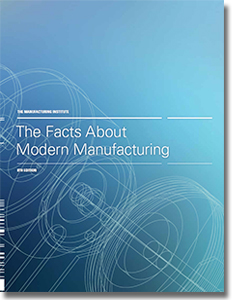U.S. Manufacturing: An Industry in Transition
The 8th edition of the Facts gives a snapshot of the state of U.S. manufacturing, and exhibits its strengths and challenges. The Facts clearly show that manufacturing continues to play a vital role in the U.S. economy.
This edition illustrates that the quantity of manufactured goods produced in the United States has kept pace with overall economic growth since 1947, as both GDP and manufacturing have grown by about seven times.
The United States still has the largest manufacturing sector in the world, and its market share (around 20 percent) has held steady for 30 years.
One in six private sector jobs is still in or directly tied to manufacturing. Moreover, productivity growth is higher in manufacturing than in other sectors of the economy. Due largely to outstanding productivity growth, the prices of manufactured goods have declined since 1995 in contrast to inflation in most other sectors, with the result that manufacturers are contributing to a higher standard of living for U.S. consumers.
Manufacturing still pays premium wages and benefits, and supports much more economic activity per dollar of production than other sectors.
Another major indicator of the importance of manufacturing to the strength of the economy is its key role in driving innovation and technology. These are crucial components of a productivity-driven, global competitiveness agenda, and also help explain the steady rise in our standard of living.
U.S. manufacturing accounts for 35 percent of value added in all of the world’s high technology production, and enjoys a trade surplus in revenues from royalties from production processes and technology. U.S. inventors still account for more than onehalf of all patents granted in the United States, and the nation outpaces its rivals in terms of industrial research and development. Technology has aided U.S. manufacturers to use less energy per unit or dollar of production and to lead all other sectors in reducing CO2 emissions in the last two decades.
Finally, the technology and advanced processes developed in manufacturing consistently spill over into productivity growth in the service and agriculture sectors. For this reason, it is important to consider innovation in terms of processes as well as technologies.
What’s Related




Favorites





